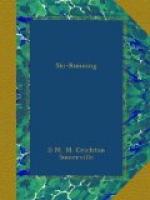All this may sound very confusing, and most beginners will probably prefer to take a Guide who knows his country well rather than trust to elementary map-reading knowledge in unknown country. Most runners who go on tour will find running much more interesting, however, if instead of following a Guide blindly they also watch the map or get a knowledge of what is good or bad country to run over. There are sometimes cases also when the party must necessarily divide, and an amateur may have to take the lead over unknown country.
AVALANCHES
Much has been written on this subject. Mr. Arnold Lunn, in “The Alps,” tells some extraordinary stories about these monsters of the mountains. My father, John Addington Symonds, in “Our Life in the Swiss Highlands,” also describes them.
There was a very interesting article by Monsieur F. Krahnstoever in the “Swiss Ski Club Year-Book for 1923” on the subject of avalanches in relation to Ski-ing. They are an everlasting nightmare to Ski runners in high places, and beginners should at once take care to learn all they can of snow-craft in order, in so far as possible, to realize what is safe and what is dangerous.
The steepness of slopes and the condition of snow, as well as the direction of wind, are all factors affecting avalanches.
Any slope whose gradient is more than 15 deg. may be dangerous under certain conditions, but it may be generally accepted that most long slopes under 25 deg. are comparatively safe so long as they have not much steeper slopes immediately above or below them.
New snow is always apt to slip before it has had time to settle down. Snow blown by wind into a cornice or overhanging lip at the top of a slope or on a cliff may topple down and start an avalanche.
Wet snow, after rain, or a warm Foehn wind, becomes heavy and begins to slide.
A very dangerous condition is new soft snow lying on a slope covered with old hard snow.
Trees or rocks sticking up through the snow make such slopes safer, as they tend to prevent the snow from beginning to slip. This is why the Forestry Laws of Switzerland are so strict. In some districts the owner of a forest may not cut a tree unless it has been approved by the Government forester. This is to ensure that the forests are maintained as a protection for the villages in the valleys below.
Beginners should never go on a tour without first ascertaining that the route they propose to follow is a safe one. And if there is the slightest doubt, owing to weather conditions, they should put it off for a day or two. Some runs are perfectly safe when the snow has settled and a sharp frost has bound it, but they may become dangerous again when a thaw sets in, a Foehn wind is blowing, or rain has fallen.
The Ski runner himself may start an avalanche on a slope where the snow would lie safely if he did not pass along it. The cutting of his track, breaking the continuity of the snow, may set it going either above or below him and he will be carried away with it.




